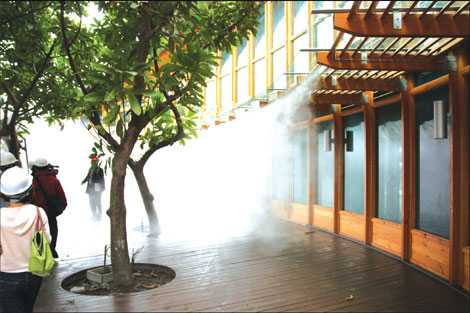Green pavilions unveiled for floral expo
Updated: 2010-03-18 07:24
(HK Edition)
|
|||||||||
|
Reporters take a tour inside one of the three environment-friendly pavilions of the 2010 Taipei International Floral Expo unveiled Wednesday. The artificial fog they see is one of the green features for maintaining an ideal micro-climate. Central News Agency |
Three environment-friendly buildings that will be among the showpieces of the Taipei International Flora Exposition were unveiled by the city government Wednesday.
Taipei Mayor Hau Lung-bin said the green buildings in the Xinsheng Park area in the northern part of the city have applied innovative design features and unique technologies to save energy, reuse water, recycle materials and protect the environment.
The project will be featured on a Discovery Channel show on Taiwan's green buildings, set to be broadcast March 27.
The three exhibition halls, called "Pavilion of Future," "Pavilion of Life" and "Pavilion of Dreams", are among the six newly-built halls for the expo, which will be held from November 6 this year through April 25, 2011, with a total of 14 pavilions.
Hau led reporters on a tour of the recently completed pavilions, touting them as examples of Taiwan's ability and initiative to work with the rest of the world in protecting Earth.
The pavilions' architect Chang Ching-hwa, who designed Taiwan's first building to receive the highest "Diamond" rating under Taiwan's EEWH green building standard, insisted on pursuing another "Diamond" rating for the three pavilions despite being given less than a year to construct them.
Chang said the buildings were designed to be integrated with nature, being shaped around existing trees on the site to prevent the cutting of old growth and remaining at about the same height as the treetops for natural shading.
The "Future" and "Life" pavilions, which will both serve as greenhouses during the expo, will be the first structures in Taiwan to use the engineering plastic ETFE - a type of transparent teflon that was used for the Beijing National Aquatics Center, widely known as the Water Cube, which served as the venue for the 2008 Olympics swimming and diving events.
The material was selected to allow enough natural light in for the plants while deflecting some of the sun's heat to give visitors a comfortable environment.
The site also utilizes an underground cooling system to feed cooler air into the "Future" pavilion and is drawing water from the Keelung River and filtering it naturally on the expo site to use as irrigation for plants being exhibited outdoors on the surrounding grounds.
"The result of this natural design has turned out pretty well," Chang said.
China Daily/CNA
(HK Edition 03/18/2010 page4)
